Great Travels: The Heidelberg Project
Last summer, I had the profound pleasure of visiting 3600 Heidelburg St., Detroit, Michigan. Spanning across blocks of urban Detroit’s east side sits one of the most extraordinary real-life art installations in the U.S., the Heidelberg Project.
The Motor City, the poster child of the Rust Belt Decay in American, saw the massive exodus of manufacturing jobs and workers by the 1970s. Once the engine of American capitalism has then been relegated to rubbles and run-down shacks and solitary flotsams of infrastructure untended on weed-strewn sidewalks. But since then the abandoned city became a frontier-land for artists, local and abroad. In the spirit of recovery, it became a hunting ground for unexpected inspirations. It was then the Heidelberg Project was born.
It’s about the graffiti. It’s about the rubbles. It’s about the rag dolls and the broken piano that sits on the sidewalk. It’s about those painted polka dots draping unoccupied house and the sculpture of derelict bicycles and shopping carts, curated by the people. It’s about that idea of the sum bigger than its individual parts. It’s about the souls who sacrificed their time and energies to bring the community back into hope, into laughter, into that sense of wonder about their future and beyond.
The Heidelberg Project is recognized around the globe as a demonstration of the power and creativity nested in the populace and the community. It is an embodiment of what art can empower at its best: a forum for healing and acceptance, celebration and discussion. It shows that art can be a solution. It can be a voice against institutions and government, a power of transformation against decrepitude. It can break the cycle of disenchantment of forgotten neighborhoods, of the once thriving and proud but since then blighted city of Detroit. It was truly an inspiration to me.



